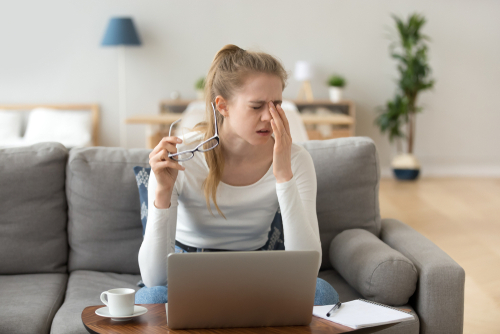Posted by: Associates in Ophthalmology (NJ) in Eyes

Dry eye syndrome can cause numerous bothersome symptoms and even make it difficult to see clearly. If you’re experiencing symptoms of dry eye syndrome, you may be wondering what steps you can take to alleviate the discomfort and improve your vision.
Before your eye doctor can treat your dry eye symptoms, they must determine what exactly is causing them. Often, dry eye symptoms stem from an issue in the tear film.
Keep reading to learn more about the tear film and what it has to do with dry eye!
What is the Tear Film?
The tear film is a thin layer of liquid covering the eye’s surface. It is composed of three layers: the lipid layer, the aqueous layer, and the mucin layer.
Each layer plays a critical role in maintaining the health and function of the eye.
Lipid Layer
The outermost layer of the tear film is the lipid layer. This layer comprises oils produced by the meibomian glands in the eyelids.
The oils help to prevent the evaporation of the tears and keep the tear film stable. If there is a problem with the meibomian glands, such as blockages or dysfunction, the lipid layer may be disrupted.
Aqueous Layer
The middle layer of the tear film is the aqueous layer. This layer is composed of water and other substances such as electrolytes, proteins, and enzymes.
The aqueous layer provides oxygen and nutrients to the cornea and helps to flush away debris and bacteria.
Muncin Layer
The mucin layer is the innermost layer. This layer is composed of mucins, which help to anchor the tear film to the surface of the eye.
Without the mucin layer, the tear film would not adhere properly to the eye, and there would be areas of dryness and irritation. Any disruption to the tear film can lead to dry eye, a common condition that can cause discomfort, blurred vision, and other symptoms.
What is Dry Eye?
Now that you know what the tear film is, you can better understand what happens when it doesn’t function properly. Dry eye is a condition that occurs when there is an insufficient amount or poor quality of tears.
One of the most common types of dry eye is evaporative dry eye. Evaporative dry eye occurs when the lipid layer of the tear film is disrupted, causing excessive evaporation of tears.
The lipid layer of the tear film is crucial in preventing the evaporation of tears. Any issue with the meibomian glands, such as blockages or dysfunction, can disrupt the lipid layer and lead to evaporative dry eye.
Similarly, if the mucin layer is not functioning properly, the tear film may not adhere to the eye’s surface correctly, leading to dryness and discomfort. Regardless of the cause, dry eye can significantly impact your quality of life and should be properly diagnosed and treated by an eye care professional.
What Treatment Methods Are Available For Dry Eye?
There are several treatment options available for dry eye. Your eye doctor at Associates in Ophthalmology will use their experience to help determine which treatment is right in each individual case.
Often the first method eye doctors use to help treat dry eye symptoms is over-the-counter and prescription eye drops, ointments, and gels. Artificial tears can provide temporary relief by lubricating the eye and supplementing the natural tears.
In more severe cases, your eye doctor may prescribe anti-inflammatory medications or medications that stimulate tear production. One innovative treatment option available at Associates in Ophthalmology for evaporative dry eye is a device called iLux.
This technology uses light-based heat therapy to melt and clear any blockages in the meibomian glands, allowing the lipid layer of the tear film to function properly.
Are you experiencing symptoms of dry eye syndrome? Schedule an appointment at Associates in Ophthalmology in Livingston, NJ, today to get started on a treatment plan that can provide you relief!

